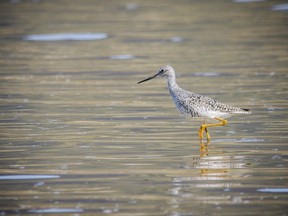BIRDWATCH: Early to arrive, late to leave - all about Greater Yellowlegs

Article content
One of the first shorebirds to arrive during the spring and fall migration and one of the last to leave for the winter is the Greater Yellowlegs.
The Greater Yellowlegs (Tringa melanoleuca) is the largest North American shorebird of this family, but is smaller than other shorebirds like the Godwits. It is about a third larger than the Lesser Yellowlegs, being 23 inches with a wingspan of 23-26 inches. It is closely related to the European Shank Family, but differs in that it has a squarish white rump patch, a dark back and a large upturned bill.
When observed in flocks of shorebirds, it is easily recognized from the other shorebirds by its large size and bright yellow legs. In the winter, this bird is much paler, with streaking and spotting on its back, neck, breast and sides.
This shorebird is found alone or in small flocks. It tends to be a wary bird and is known for its whistled call that warns the other shorebirds of approaching dangers.
The Greater Yellowlegs feeds by skimming the water with its bill, not probing like the Dowitcher family. It sometimes darts out in pursuit of small fish. It enjoys eating insects, large larvae, crabs, snails and small fish.
The Greater Yellowlegs is a solitary breeder. It builds its nest in moss on a small hammock near water. The nest in the moss is lined with grasses and leaves.
The shorebird is monogamous and has only one brood per year. The eggs of the Greater Yellowlegs are incubated for 23 days by both sexes. The young leave the nest shortly after being hatched and are capable of feeding themselves. The young are watched over by the adults until their first flight in 18-20 days.
The Greater Yellowlegs is fairly common. It breeds in Northern Canada and winters in both coastal oceans, the Gulf of Mexico and parts of Mexico.
This shorebird is in no danger of extinction. The next time you see a flock of shorebirds, either on the beach or in a mudhole in a field, look for this interesting bird.
Locally, the fall migration is in full swing as more birds continue to stage, especially Canada Geese, Blackbirds, Robins, Northern Flickers and Sparrows. There may even be reports of early migrating Horned and Red-necked Grebes in the area as well as pockets of warblers, songbirds, thrush and sparrows. Look for these along the brush near roads, in trees by our lakes and rivers.
This is the peak period for shorebird migration. While most of these birds will pass through our area at night, the odd bird will stop to feed along our beaches and shorelines. Large bird lands sometimes occur just before pending storms. The Pembroke Area Field Naturalists will be holding its Marina Walk on Saturday, Sept. 17; hopefully, shorebirds will still be present.
The Ruby-throated Hummingbirds are starting to leave our area. I recommend keeping your Hummingbird feeders up until at least the third week of September for any late Hummers passing through from the north. Please note that the Hummers leave in the following order: the males first, females second and then the juveniles.
This is also a great time to enjoy migrant bird life along the Pembroke waterfront. There are usually Terns, Gulls, Ducks, occasional shorebirds and several songbirds, including Vireos Warblers, Sparrows and Finches in the trees nearby and along the tracks behind Algonquin College.
On Aug.18, Rob Cunningham of Barren Canyon Road spotted a flock of 10 Semi-palmeated Sandpipers at the Pembroke marina, and Mark Dojczman of Pembroke observed a Least Sandpiper also there.
On Aug. 20, Vince Agnesi of Sheenboro photographed a Solitary Sandpiper in a mudhole near Fort William.
On Aug. 21, Nancy Stead Wilcox posted an excellent picture of an Osprey carrying a stick back to its nest. Can this bird be planning a second brood this year?
The next day, Ron Bertrand informed me that there was a Snow Goose among a flock of Canada Geese on Golf Course Road. It is always neat to find one of these birds in the fall.
On this same date, Aug. 22, I visited the Pembroke marina early in the morning and was pleased to observe the following shorebirds: Semi-palmeated Sandpiper, Spotted Sandpiper, Semi-palmeated Plovers and a Baird’s Sandpiper.
Around this same time, Nancy Stead Wilcox located a small flock of Sandhill Cranes in Westmeath. Sandhill Cranes are beginning their trek south, so expect to see flocks of these magnificent birds in our area in the next two months.
On Aug. 23, Leo Boland spotted a flock of Sandhill Cranes on Ross Road and three Black-crowned Herons at the Micksburg Swamp.
The next day, Wayne Thompson of Laurentian Hills informed me a colleague of his spotted a Snow Bunting in his area. Wayne also informed me that he heard that several northern species like Pine Siskins were already making appearances in some northern Ontario places. Could we be having an early winter this year?
On Aug. 25, Allan Mills of Elizabeth Street informed me that he had two Northern Flickers and a Red-breasted Nuthatch at his bird feeders.
Finally, on Aug. 28, Misty Greig of Pembroke took excellent photos of a female Ruby-throated Hummingbird at her feeders.
Please call me with your bird sightings at 613-735-4430 or email me at hooles@bell.net . For more information on upcoming nature events just google the Pembroke Area Field Naturalists’ website or like us on Facebook.
Postmedia is committed to maintaining a lively but civil forum for discussion. Please keep comments relevant and respectful. Comments may take up to an hour to appear on the site. You will receive an email if there is a reply to your comment, an update to a thread you follow or if a user you follow comments. Visit our Community Guidelines for more information.